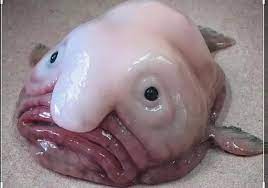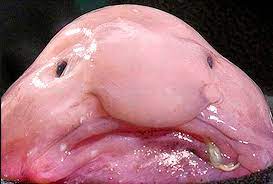In the depths of the ocean, where pressure is crushing and temperatures are freezing, lives a creature that has become infamous for its peculiar appearance – the Blobfish. Often referred to as the world’s ugliest fish, the Blobfish has captured the curiosity and imagination of people worldwide. Join us as we dive into the mysterious world of the Blobfish, exploring its unique adaptations, habitat, and the truth behind its infamous “blob-like” appearance.

- A Bizarre Appearance:
The Blobfish (Psychrolutes marcidus) belongs to the family Psychrolutidae and is known for its gelatinous and saggy appearance. It lacks a swim bladder, which allows it to maintain neutral buoyancy in the extreme depths of the ocean. This unique adaptation is responsible for its unusual, “blob-like” appearance, making it quite distinct from most other fish species.
- Deep-Sea Dweller:
The Blobfish is found in the deep waters off the coasts of Australia, Tasmania, and New Zealand, at depths ranging from 600 to 1200 meters. In these depths, the pressure is several times higher than at the surface, and the temperatures are near freezing, creating an inhospitable environment for most life forms.
- Adaptations to Extreme Conditions:
To survive in the harsh deep-sea environment, the Blobfish has evolved some remarkable adaptations. Its gelatinous flesh has a density that is slightly less than water, enabling it to float effortlessly above the seabed. The lack of a swim bladder also prevents it from wasting energy to maintain buoyancy, allowing it to conserve energy in the low-energy environment of the deep ocean.
- Feeding Behavior:
The Blobfish is a bottom-dwelling fish that primarily feeds on small crustaceans and other deep-sea invertebrates. With its gelatinous appearance, it does not actively pursue prey like some other fish species but relies on opportunistic feeding. It waits patiently for food to come within reach of its mouth before engulfing it with its large, fleshy lips.
- Conservation Concerns:
The Blobfish is currently listed as “Vulnerable” by the International Union for Conservation of Nature (IUCN). While not targeted directly by fisheries, it often becomes a bycatch in deep-sea trawl fisheries, where it is accidentally captured along with target species. Additionally, its slow reproductive rate and limited distribution make it vulnerable to population declines from human-induced threats.
- The “Ugliest” Fish:
The Blobfish gained notoriety in popular media as the “world’s ugliest fish” when images of its drooping, gelatinous appearance went viral. It is essential to recognize that beauty is subjective and that all living creatures play unique roles in their ecosystems. While the Blobfish might not fit traditional beauty standards, its adaptations and survival strategies are a testament to the incredible diversity of life in the oceans.
- Blobfish in Pop Culture:
The Blobfish’s peculiar appearance has made it a subject of fascination in pop culture, appearing in memes, cartoons, and even merchandise. Unfortunately, this attention sometimes leads to misconceptions and reinforces the idea that appearance defines worth. Educating the public about the Blobfish’s significance in its ecosystem is crucial to promoting a deeper understanding of marine biodiversity.
- Scientific Research and Exploration:
Despite its mysterious nature, scientific research on the Blobfish remains limited due to the challenges of studying deep-sea creatures. Advances in technology and deep-sea exploration have provided new opportunities to study this enigmatic species and shed light on its biology and behavior.
Conclusion:
The Blobfish might not win any beauty contests, but its extraordinary adaptations and resilience make it a fascinating creature deserving of our admiration and conservation efforts. As we explore the depths of the ocean, it is crucial to remember that every species, no matter how unusual, plays a crucial role in the intricate web of life. By understanding and appreciating the Blobfish, we can foster a deeper appreciation for the wonders of the ocean and the diverse array of life it sustains.



















Add Comment